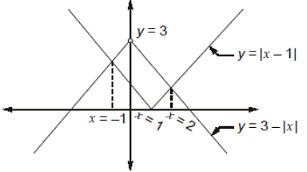Electronics and Communication Engineering (ECE) Exam > Electronics and Communication Engineering (ECE) Questions > The area of the region bounded by the curves...
Start Learning for Free
The area of the region bounded by the curves y = |x – 1| and y = 3 - |x| is
- a)2 sq. units
- b)3 sq. units
- c)4 sq. units
- d)6 sq. units
Correct answer is option 'C'. Can you explain this answer?
Most Upvoted Answer
The area of the region bounded by the curves y = |x – 1| and y = 3 - ...
To find the area of the region bounded by the curves y = |x – 1| and y = 3 - |x|, we need to first determine the points of intersection between the two curves.
Step 1: Finding the points of intersection
To find the points of intersection, we equate the two equations and solve for x:
|x – 1| = 3 - |x|
Since the absolute value function can be written as two separate equations, we have two cases:
Case 1: When x – 1 ≥ 0, we have |x – 1| = x – 1
So the equation becomes:
x – 1 = 3 - |x|
Case 2: When x – 1 < 0,="" we="" have="" |x="" –="" 1|="-(x" –="" 1)="-x" +="" />
So the equation becomes:
-x + 1 = 3 - |x|
Solving each case separately:
Case 1:
x – 1 = 3 - |x|
x – 1 = 3 - x (since x ≥ 1, |x| = x)
2x = 4
x = 2
Case 2:
-x + 1 = 3 - |x|
-x + 1 = 3 - (-x + 1) (since x < 1,="" |x|="-x" +="" />
-x + 1 = 3 + x - 1
-2x = 2
x = -1
So the curves intersect at x = 2 and x = -1.
Step 2: Determining the limits of integration
To find the area between the curves, we need to determine the limits of integration. The curves y = |x – 1| and y = 3 - |x| intersect at x = 2 and x = -1. So the limits of integration for x will be -1 to 2.
Step 3: Evaluating the integral
The area between the curves can be found by taking the integral of the difference between the two curves with respect to x:
Area = ∫[from -1 to 2] [(3 - |x|) - |x – 1|] dx
To simplify the integral, we can break it up into two parts, one for each case:
Area = ∫[from -1 to 1] [(3 - (-x + 1)) - (-x + 1)] dx + ∫[from 1 to 2] [(3 - x) - (x – 1)] dx
Simplifying each integral:
Area = ∫[from -1 to 1] (4 + x) dx + ∫[from 1 to 2] (2 - 2x) dx
Area = [4x + (x^2)/2] [from -1 to 1] + [2x - x^2] [from 1 to 2]
Area = [(4 + 1/2) - (-4 + 1/2)] + [(4 - 2) - (2 - 1)]
Area = [9/2 - 7/2] + [2 - 1]
Area = 2 + 1
Area = 3 sq. units
Therefore, the
Step 1: Finding the points of intersection
To find the points of intersection, we equate the two equations and solve for x:
|x – 1| = 3 - |x|
Since the absolute value function can be written as two separate equations, we have two cases:
Case 1: When x – 1 ≥ 0, we have |x – 1| = x – 1
So the equation becomes:
x – 1 = 3 - |x|
Case 2: When x – 1 < 0,="" we="" have="" |x="" –="" 1|="-(x" –="" 1)="-x" +="" />
So the equation becomes:
-x + 1 = 3 - |x|
Solving each case separately:
Case 1:
x – 1 = 3 - |x|
x – 1 = 3 - x (since x ≥ 1, |x| = x)
2x = 4
x = 2
Case 2:
-x + 1 = 3 - |x|
-x + 1 = 3 - (-x + 1) (since x < 1,="" |x|="-x" +="" />
-x + 1 = 3 + x - 1
-2x = 2
x = -1
So the curves intersect at x = 2 and x = -1.
Step 2: Determining the limits of integration
To find the area between the curves, we need to determine the limits of integration. The curves y = |x – 1| and y = 3 - |x| intersect at x = 2 and x = -1. So the limits of integration for x will be -1 to 2.
Step 3: Evaluating the integral
The area between the curves can be found by taking the integral of the difference between the two curves with respect to x:
Area = ∫[from -1 to 2] [(3 - |x|) - |x – 1|] dx
To simplify the integral, we can break it up into two parts, one for each case:
Area = ∫[from -1 to 1] [(3 - (-x + 1)) - (-x + 1)] dx + ∫[from 1 to 2] [(3 - x) - (x – 1)] dx
Simplifying each integral:
Area = ∫[from -1 to 1] (4 + x) dx + ∫[from 1 to 2] (2 - 2x) dx
Area = [4x + (x^2)/2] [from -1 to 1] + [2x - x^2] [from 1 to 2]
Area = [(4 + 1/2) - (-4 + 1/2)] + [(4 - 2) - (2 - 1)]
Area = [9/2 - 7/2] + [2 - 1]
Area = 2 + 1
Area = 3 sq. units
Therefore, the
Free Test
FREE
| Start Free Test |
Community Answer
The area of the region bounded by the curves y = |x – 1| and y = 3 - ...

Required area



|
Explore Courses for Electronics and Communication Engineering (ECE) exam
|

|
The area of the region bounded by the curves y = |x – 1| and y = 3 - |x| isa)2 sq. unitsb)3 sq. unitsc)4 sq. unitsd)6 sq. unitsCorrect answer is option 'C'. Can you explain this answer?
Question Description
The area of the region bounded by the curves y = |x – 1| and y = 3 - |x| isa)2 sq. unitsb)3 sq. unitsc)4 sq. unitsd)6 sq. unitsCorrect answer is option 'C'. Can you explain this answer? for Electronics and Communication Engineering (ECE) 2025 is part of Electronics and Communication Engineering (ECE) preparation. The Question and answers have been prepared according to the Electronics and Communication Engineering (ECE) exam syllabus. Information about The area of the region bounded by the curves y = |x – 1| and y = 3 - |x| isa)2 sq. unitsb)3 sq. unitsc)4 sq. unitsd)6 sq. unitsCorrect answer is option 'C'. Can you explain this answer? covers all topics & solutions for Electronics and Communication Engineering (ECE) 2025 Exam. Find important definitions, questions, meanings, examples, exercises and tests below for The area of the region bounded by the curves y = |x – 1| and y = 3 - |x| isa)2 sq. unitsb)3 sq. unitsc)4 sq. unitsd)6 sq. unitsCorrect answer is option 'C'. Can you explain this answer?.
The area of the region bounded by the curves y = |x – 1| and y = 3 - |x| isa)2 sq. unitsb)3 sq. unitsc)4 sq. unitsd)6 sq. unitsCorrect answer is option 'C'. Can you explain this answer? for Electronics and Communication Engineering (ECE) 2025 is part of Electronics and Communication Engineering (ECE) preparation. The Question and answers have been prepared according to the Electronics and Communication Engineering (ECE) exam syllabus. Information about The area of the region bounded by the curves y = |x – 1| and y = 3 - |x| isa)2 sq. unitsb)3 sq. unitsc)4 sq. unitsd)6 sq. unitsCorrect answer is option 'C'. Can you explain this answer? covers all topics & solutions for Electronics and Communication Engineering (ECE) 2025 Exam. Find important definitions, questions, meanings, examples, exercises and tests below for The area of the region bounded by the curves y = |x – 1| and y = 3 - |x| isa)2 sq. unitsb)3 sq. unitsc)4 sq. unitsd)6 sq. unitsCorrect answer is option 'C'. Can you explain this answer?.
Solutions for The area of the region bounded by the curves y = |x – 1| and y = 3 - |x| isa)2 sq. unitsb)3 sq. unitsc)4 sq. unitsd)6 sq. unitsCorrect answer is option 'C'. Can you explain this answer? in English & in Hindi are available as part of our courses for Electronics and Communication Engineering (ECE).
Download more important topics, notes, lectures and mock test series for Electronics and Communication Engineering (ECE) Exam by signing up for free.
Here you can find the meaning of The area of the region bounded by the curves y = |x – 1| and y = 3 - |x| isa)2 sq. unitsb)3 sq. unitsc)4 sq. unitsd)6 sq. unitsCorrect answer is option 'C'. Can you explain this answer? defined & explained in the simplest way possible. Besides giving the explanation of
The area of the region bounded by the curves y = |x – 1| and y = 3 - |x| isa)2 sq. unitsb)3 sq. unitsc)4 sq. unitsd)6 sq. unitsCorrect answer is option 'C'. Can you explain this answer?, a detailed solution for The area of the region bounded by the curves y = |x – 1| and y = 3 - |x| isa)2 sq. unitsb)3 sq. unitsc)4 sq. unitsd)6 sq. unitsCorrect answer is option 'C'. Can you explain this answer? has been provided alongside types of The area of the region bounded by the curves y = |x – 1| and y = 3 - |x| isa)2 sq. unitsb)3 sq. unitsc)4 sq. unitsd)6 sq. unitsCorrect answer is option 'C'. Can you explain this answer? theory, EduRev gives you an
ample number of questions to practice The area of the region bounded by the curves y = |x – 1| and y = 3 - |x| isa)2 sq. unitsb)3 sq. unitsc)4 sq. unitsd)6 sq. unitsCorrect answer is option 'C'. Can you explain this answer? tests, examples and also practice Electronics and Communication Engineering (ECE) tests.

|
Explore Courses for Electronics and Communication Engineering (ECE) exam
|

|
Signup for Free!
Signup to see your scores go up within 7 days! Learn & Practice with 1000+ FREE Notes, Videos & Tests.
























